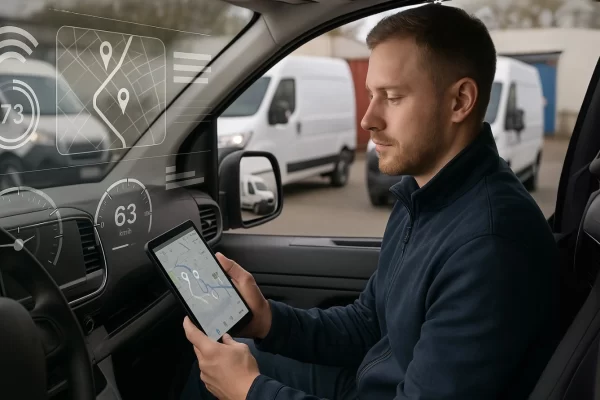CHANGING DRIVER BEHAVIOR
GPS vehicle tracking provides a powerful tool for managing your vehicles more effectively, helping you control fleet costs and improve productivity. But operating a fleet isn’t just about managing vehicles – it also requires managing the people that drive them. That’s where a wireless fleet management system can provide many benefits for your company and its drivers.
The vehicle and driver performance data provided by a telematics solution like GPS vehicle tracking can help you:
- Improve driver safety
- Reduce unnecessary idling
- Reduce unauthorized vehicle use
- Control fuel and other operational costs
- Improve vehicle utilization
- Improve productivity and customer service
Coaching your drivers to adopt better driving habits can boost the productivity of your fleet and the profitability of your business. GPS tracking provides the tools to accomplish both.
Using GPS data in a positive manner can allow you to coach and reward drivers to adopt safer, more efficient driving habits. Start by getting drivers involved in the implementation and use of GPS tracking so they understand how the system works. Then provide examples of how GPS tracking will directly benefit them, as well as the company. Emphasize that the system is not a tool for micro- managing drivers. Rather, it’s a resource that can be used by everyone to improve their performance and help the business grow.
Once drivers gain experience with the system, they usually come to depend on it for important information, roadside assistance, verification of work performed on time, and data that impacts many other aspects of their jobs. When implemented with a disciplined approach that includes changing driver behavior, GPS tracking can lead to dramatic productivity improvements that deliver a substantial return on your investment.
IMPROVE DRIVER SAFETY
Driver safety is the top priority for every fleet. Yet, drivers can put themselves and others on the road in danger with excessive speeding and other risky driving behaviors. By monitoring the location and speed of every vehicle in your fleet, GPS tracking provides the data you need to coach drivers to slow down and drive safer.
- Speeding alerts notify you in near-realtime when speeding incidents occur. You determine the alert criteria, such as speed thresholds, time of day, and type of vehicle, and the system automatically sends you a text or e-mail when a violation occurs.
- Speeding reports provides ummary data on all speed-related incidents. These can be scheduled for automated delivery on a daily, weekly, or monthly basis, allowing you to identify current violations as well as month-by-month trends.
GPS tracking can also monitor hard breaking, fast acceleration, and other risky driving behaviors. Armed with this data, you can put policies in place and provide coaching and reinforcement to encourage drivers to protect themselves and others on the road.
REDUCE FLEET IDLE TIMES
Idling wastes fuel, adversely affects engine wear, and contributes to air pollution. In fact, the U.S. Department of Transportation estimates that medium-duty trucks burn about 2.5 billion gallons of fuel while idling each year, or 6.7% of the total fuel they consume1 . Most commercial fleets can’t eliminate idling. But you can use remote vehicle monitoring to cut down on unnecessary idling, thereby lowering fuel usage and extending the lives of your vehicles.
- Monitor vehicle idle times 24×7 and set thresholds to determine which vehicles consistently exceed preset idle times.
- Access data from customizable alert notices and reports to control idle times and reduce fleet emissions.
- Compare idle times and fuel consumption between vehicles to identify drivers that regularly violate policies or vehicles that may need servicing.
- Track fuel efficiency overtime to determine whether other factors besides idling are driving up fuel consumption.
In addition to idle time alerts, customizable reports provide the data needed to set idle time reduction goals and coach drivers to achieve the desired results. Giving your drivers feedback on their idle times will make them more aware of their habits and encourage them to idle their vehicles only when necessary.
By monitoring the location and speed of every vehicle in your fleet, you can coach drivers to slow down and drive safer.
REDUCE UNAUTHORIZED VEHICLE USE
Unauthorized personal use of company vehicles can drive up fuel and maintenance costs and reduce the service life of your vehicles. GPS tracking can help nip this common activity in the bud by providing multiple tools for monitoring after-hours usage.
- The odd hours/movement report identifies when and where vehicles are being used during weekends, after work, and other unauthorized hours.
- The odd hours alert identifies unauthorized vehicle usage as it occurs so you can take immediate action.
When drivers know their vehicle usage is being monitored and measured, unauthorized usage declines.
BOOST DRIVER PRODUCTIVITY
GPS vehicle tracking can help boost driver productivity in many ways, allowing you to:
- Track vehicle stop/start times. Alerts and reports let you monitor driver behavior to verify that they are complying with company break policies.
- Improve on-time arrival. Near real-time alerts help you manage vehicles to get them where they need to be on time. Staying on schedule lets your drivers make more deliveries in less time.
- Do more jobs without adding overhead. Improved dispatching and better routing can help your drivers take on more jobs in a day.
Remotely monitoring engine diagnostics can help cut down on unnecessary idling, lower fuel usage, and extend the service life of your vehicles.
REDUCE FUEL USE
Most fleet managers work hard to reduce fuel usage and keep those costs in check. But unless improving fuel efficiency becomes a company-wide effort, any cost savings are likely to be minimal. GPS tracking gives everyone in the organization, including your drivers, the information and tools they need to improve fuel efficiency and cut costs.
Using telematics data to change driver behavior, you can lower fleet idle times, reduce speeding, decrease unauthorized vehicle use, improve routing efficiency, and more. All of which help to reduce fuel consumption and the associated costs.
Some telematics systems also offer national fuel card programs to provide more control over fuel purchases. Providing drivers with these cards can help control fuel costs by allowing you to verify the time, location and amount of all fuel transactions.
GPS tracking can help reduce or eliminate unauthorized vehicle use by providing multiple tools for monitoring after- hours usage.
COACH AND REWARD YOUR DRIVERS
Changing driver behavior requires three basic steps:
- Set goals
- Educate and coach drivers on how to achieve the goals
- Reward good performance
Remember that drivers are more likely to embrace a telematics system when you emphasize the positive aspects. Start by establishing clear company policies so that drivers understand how GPS tracking will be used to measure their performance. Then explain that the data obtained from the system will be used as a training tool to reduce costs, improve driving habits, and increase driver safety. Make it clear that drivers who fail to comply with company policies will be held accountable. However, the primary focus should be on rewarding drivers for developing better driving habits.
Rewards can come in many different forms, including bonuses, gift cards, time off, or other perks. GPS data can be used to create contests that motivate drivers to improve performance and achieve company goals. You may consider holding company events to publicly recognize drivers who achieve the desired performance levels.
When drivers work more efficiently, you can complete more jobs in the same amount of time, improve on-time deliveries, and satisfy customers as you deliver faster, more responsive service.
THE TRAXXIS GPS SOLUTION
Our Networkfleet telematics system helps you control costs, automate and streamline processes, and utilize your people and your vehicles more effectively. The result is a leaner, more efficient fleet that helps improve your business and your bottom line.
These results are more easily achieved when you use the data to change inefficient driver behaviors. Use Networkfleet performance data to set clear, measurable goals for improvement. Train your drivers on how to achieve them. Then reward them when they do. When you have a GPS system like Networkfleet and a team of drivers that understands how to use it, everyone benefits.





